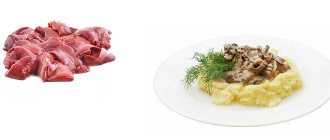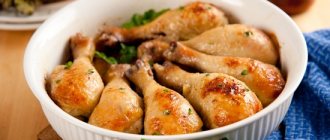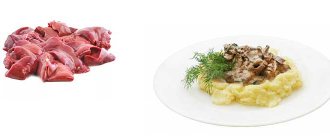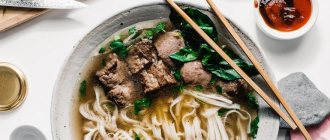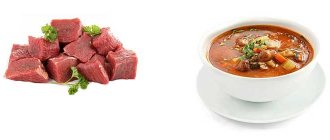Chicken fillet contains per 100 grams of product: Calories: 110 kcal.
(460.24 kJ.) Proteins:
23.1 g.
Fats:
1.2 g.
Carbohydrates:
0 g.
Information about the calorie content of the product is taken as an average from various sources and may differ from the actual one depending on the variety, type or other characteristics of a particular product.
The calorie content of 100 grams of fried chicken (of which 30.6 g protein, 9.1 g fat and 1.7 g carbohydrates) is 219 kcal or 916 kJ. 219 kcal per 100 g is 9.5% of the average daily value.
How to burn calories from 100 g of fried chicken
For example, to burn all the calories from 100 grams of fried chicken, you would need 18 minutes of running or 3 hours and 29 minutes of sleep.
>»> >»> >»> >»> >»> >»> >»> >»> >»> >»> >»> >»> >»> >»> >»>
| Activity | Calorie content per day per 100 g | |
| Dream | 3 hours 29 minutes | 15% |
| Meditation | 3 hours 07 minutes | 13% |
| Rest | 2 hours 51 minutes | 12% |
| Reading books, Internet | 2 hours 24 minutes | 10% |
| Sex | 1 hour 29 minutes | 6% |
| Yoga, Pilates | 0h 59 min | 4% |
| Dancing | 0h 55 min | 4% |
| Walking | 0h 49 min | 3% |
| Football | 0h 29 min | 2% |
| Swimming | 0h 28 min | 2% |
| Abs workout | 0 h 25 min | 2% |
| Power training | 0 h 25 min | 2% |
| A ride on the bicycle | 0h 23 min | 2% |
| Jumping rope | 0h 19 min | 1% |
| Run | 0h 18 min | 1% |
Calories in fried chicken breast. Chemical composition and nutritional value.
Nutritional value and chemical composition of “fried chicken breast”.
The table shows the nutritional content (calories, proteins, fats, carbohydrates, vitamins and minerals) per 100 grams of edible portion.
| Nutrient | Quantity | Norm** | % of the norm in 100 g | % of the norm in 100 kcal | 100% normal |
| Calorie content | 174 kcal | 1684 kcal | 10.3% | 5.9% | 968 g |
| Squirrels | 25.11 g | 76 g | 33% | 19% | 303 g |
| Fats | 7.88 g | 56 g | 14.1% | 8.1% | 711 g |
| Carbohydrates | 1.34 g | 219 g | 0.6% | 0.3% | 16343 g |
| Vitamins | |||||
| Vitamin B1, thiamine | 0.1 mg | 1.5 mg | 6.7% | 3.9% | 1500 g |
| Vitamin B2, riboflavin | 0.2 mg | 1.8 mg | 11.1% | 6.4% | 900 g |
| Niacin | 8.3 mg | ~ | |||
| Macronutrients | |||||
| Potassium, K | 264 mg | 2500 mg | 10.6% | 6.1% | 947 g |
| Calcium, Ca | 14 mg | 1000 mg | 1.4% | 0.8% | 7143 g |
| Sodium, Na | 66 mg | 1300 mg | 5.1% | 2.9% | 1970 |
| Phosphorus, P | 210 mg | 800 mg | 26.3% | 15.1% | 381 g |
| Microelements | |||||
| Iron, Fe | 1.1 mg | 18 mg | 6.1% | 3.5% | 1636 g |
| Yod, I | 6.9 mcg | 150 mcg | 4.6% | 2.6% | 2174 g |
| Sterols (sterols) | |||||
| Cholesterol | 60 mg | max 300 mg | |||
| Saturated fatty acids | |||||
| Saturated fatty acids | 0.25 g | max 18.7 g | |||
| Monounsaturated fatty acids | 0.19 g | min 16.8 g | 1.1% | 0.6% | |
| Polyunsaturated fatty acids | 0.23 g | from 11.2 to 20.6 g | 2.1% | 1.2% |
The energy value of fried chicken breast is 174 kcal.
Primary Source: Created in the application by the user. Read more.
** This table shows the average levels of vitamins and minerals for an adult. If you want to know the norms taking into account your gender, age and other factors, then use the “My Healthy Diet” application.
Source
Report errors and inaccuracies
- 0.2 pieces chicken (without skin and bones)
- 0.7 glasses of finely chopped meat 1 glass - how much?
- Weight with waste 172.4 g Waste: bone 29%, skin 13% (42% of weight). The calculations use the weight of only the edible part of the product.
Listed below are the nutrient standards that apply to the site.
Chicken is a popular product that regularly appears on our tables. Many people like chicken fried or baked in the oven without oil, while others prefer it boiled or stewed.
As a rule, poultry meat is salted, but sometimes it is eaten without salt, replacing it with aromatic herbs and seasonings. The variety of chicken preparations is simply amazing. But what are the calories in chicken cooked in different ways? Let's find out more!
Recipe: Fried chicken breast. Calorie, chemical composition and nutritional value.
Fried chicken breast is rich in vitamins and minerals such as: vitamin B5 - 36.4%, vitamin B6 - 40%, vitamin E - 19.2%, vitamin PP - 46.8%, potassium - 13.2%, magnesium - 24.4%, phosphorus - 24%, chlorine - 41.3%, cobalt - 115.7%, molybdenum - 19.6%, selenium - 44.5%, chromium - 55.1%, zinc - 14.3 %
- Vitamin B5 is involved in protein, fat, carbohydrate metabolism, cholesterol metabolism, the synthesis of a number of hormones, hemoglobin, promotes the absorption of amino acids and sugars in the intestines, and supports the function of the adrenal cortex. A lack of pantothenic acid can lead to damage to the skin and mucous membranes.
- Vitamin B6 is involved in maintaining the immune response, processes of inhibition and excitation in the central nervous system, in the transformation of amino acids, the metabolism of tryptophan, lipids and nucleic acids, promotes the normal formation of red blood cells, and maintaining normal levels of homocysteine in the blood. Insufficient intake of vitamin B6 is accompanied by decreased appetite, impaired skin condition, and the development of homocysteinemia and anemia.
- Vitamin E has antioxidant properties, is necessary for the functioning of the gonads and heart muscle, and is a universal stabilizer of cell membranes. With vitamin E deficiency, hemolysis of erythrocytes and neurological disorders are observed.
- Vitamin PP is involved in redox reactions of energy metabolism. Insufficient vitamin intake is accompanied by disruption of the normal condition of the skin, gastrointestinal tract and nervous system.
- Potassium is the main intracellular ion that takes part in the regulation of water, acid and electrolyte balance, and is involved in the processes of conducting nerve impulses and regulating blood pressure.
- Magnesium is involved in energy metabolism, the synthesis of proteins, nucleic acids, has a stabilizing effect on membranes, and is necessary to maintain the homeostasis of calcium, potassium and sodium. A lack of magnesium leads to hypomagnesemia, an increased risk of developing hypertension and heart disease.
- Phosphorus takes part in many physiological processes, including energy metabolism, regulates acid-base balance, is part of phospholipids, nucleotides and nucleic acids, and is necessary for the mineralization of bones and teeth. Deficiency leads to anorexia, anemia, and rickets.
- Chlorine is necessary for the formation and secretion of hydrochloric acid in the body.
- Cobalt is part of vitamin B12. Activates enzymes of fatty acid metabolism and folic acid metabolism.
- Molybdenum is a cofactor for many enzymes that ensure the metabolism of sulfur-containing amino acids, purines and pyrimidines.
- Selenium is an essential element of the antioxidant defense system of the human body, has an immunomodulatory effect, and is involved in the regulation of the action of thyroid hormones. Deficiency leads to Kashin-Beck disease (osteoarthritis with multiple deformities of the joints, spine and limbs), Keshan disease (endemic myocardiopathy), and hereditary thrombasthenia.
- Chromium is involved in the regulation of blood glucose levels, enhancing the effect of insulin. Deficiency leads to decreased glucose tolerance.
- Zinc is part of more than 300 enzymes and is involved in the processes of synthesis and breakdown of carbohydrates, proteins, fats, nucleic acids and in the regulation of the expression of a number of genes. Insufficient consumption leads to anemia, secondary immunodeficiency, liver cirrhosis, sexual dysfunction, and the presence of fetal malformations. Research in recent years has revealed the ability of high doses of zinc to disrupt the absorption of copper and thereby contribute to the development of anemia.
Composition and nutritional value of chicken
No type of meat contains as many important substances for the human body as chicken. It contains calcium, magnesium, phosphorus, potassium, iron, as well as valuable vitamins A, B1, B2, B2, B3, B5, B6, B9, C, E and a number of amino acids. But the most important thing is that it is a source of easily digestible protein, which activates the growth of muscle mass.
Useful properties of chicken meat:
- activation of muscle growth;
- strengthening nails and hair;
- acceleration of metabolic processes in the body;
- positive effect on the functioning of the reproductive organs;
- normalization of the nervous system, reduction of stress and anxiety levels;
- maintaining normal blood pressure.
Recipe Fried chicken breast 1. Calorie content, chemical composition and nutritional value.
Fried chicken breast 1 is rich in vitamins and minerals such as: vitamin B5 - 38.5%, vitamin B6 - 42.2%, vitamin PP - 49.4%, potassium - 13.9%, magnesium - 25.7%, phosphorus - 25.2%, cobalt - 119.9%, copper - 11.1%, molybdenum - 18.3%, selenium - 46.9%, chromium - 58.2%, zinc - 15.1%
- Vitamin B5 is involved in protein, fat, carbohydrate metabolism, cholesterol metabolism, the synthesis of a number of hormones, hemoglobin, promotes the absorption of amino acids and sugars in the intestines, and supports the function of the adrenal cortex. A lack of pantothenic acid can lead to damage to the skin and mucous membranes.
- Vitamin B6 is involved in maintaining the immune response, processes of inhibition and excitation in the central nervous system, in the transformation of amino acids, the metabolism of tryptophan, lipids and nucleic acids, promotes the normal formation of red blood cells, and maintaining normal levels of homocysteine in the blood. Insufficient intake of vitamin B6 is accompanied by decreased appetite, impaired skin condition, and the development of homocysteinemia and anemia.
- Vitamin PP is involved in redox reactions of energy metabolism. Insufficient vitamin intake is accompanied by disruption of the normal condition of the skin, gastrointestinal tract and nervous system.
- Potassium is the main intracellular ion that takes part in the regulation of water, acid and electrolyte balance, and is involved in the processes of conducting nerve impulses and regulating blood pressure.
- Magnesium is involved in energy metabolism, the synthesis of proteins, nucleic acids, has a stabilizing effect on membranes, and is necessary to maintain the homeostasis of calcium, potassium and sodium. A lack of magnesium leads to hypomagnesemia, an increased risk of developing hypertension and heart disease.
- Phosphorus takes part in many physiological processes, including energy metabolism, regulates acid-base balance, is part of phospholipids, nucleotides and nucleic acids, and is necessary for the mineralization of bones and teeth. Deficiency leads to anorexia, anemia, and rickets.
- Cobalt is part of vitamin B12. Activates enzymes of fatty acid metabolism and folic acid metabolism.
- Copper is part of enzymes that have redox activity and are involved in the metabolism of iron, stimulates the absorption of proteins and carbohydrates. Participates in the processes of providing oxygen to the tissues of the human body. Deficiency is manifested by disturbances in the formation of the cardiovascular system and skeleton, and the development of connective tissue dysplasia.
- Molybdenum is a cofactor for many enzymes that ensure the metabolism of sulfur-containing amino acids, purines and pyrimidines.
- Selenium is an essential element of the antioxidant defense system of the human body, has an immunomodulatory effect, and is involved in the regulation of the action of thyroid hormones. Deficiency leads to Kashin-Beck disease (osteoarthritis with multiple deformities of the joints, spine and limbs), Keshan disease (endemic myocardiopathy), and hereditary thrombasthenia.
- Chromium is involved in the regulation of blood glucose levels, enhancing the effect of insulin. Deficiency leads to decreased glucose tolerance.
- Zinc is part of more than 300 enzymes and is involved in the processes of synthesis and breakdown of carbohydrates, proteins, fats, nucleic acids and in the regulation of the expression of a number of genes. Insufficient consumption leads to anemia, secondary immunodeficiency, liver cirrhosis, sexual dysfunction, and the presence of fetal malformations. Research in recent years has revealed the ability of high doses of zinc to disrupt the absorption of copper and thereby contribute to the development of anemia.
Calorie content of chicken (per 100 g)
The calorie content of raw chicken with skin is 190 kcal. It also contains:
- proteins - 19.12 g;
- fats - 12.10 g;
- carbohydrates - 0.30 g.
Photo source: shutterstock.com
The calorie content of raw skinless chicken is reduced to 178 calories, and the amount of fat is reduced by almost a third - to 7.23 grams. The amount of protein is 19.55 g, and the amount of carbohydrates is only 0.26 g.
Bzhu and kbju of chicken breast per 100 grams
The breast is the lowest calorie part of the whole carcass. It has almost 4 times less fat than ham. Optimal ratio of macro- and microelements, chromium, sulfur, magnesium, phosphorus, cobalt present. Lots of vitamins, PP, C, A, E and group B.
Boiled
To get the maximum benefit from boiled meat, it is better to boil it without skin, and be sure to drain the first broth.
Boiled chicken breast bju without skin per 100 g:
- 29.8 g protein;
- 1.8 g fat;
- 0.5 g carbohydrates.
Calorie content is 137 kcal.
This dish is recommended for consumption even in early childhood.
The broth obtained during the boiling process can also be consumed; its calorie content, if nothing except salt is added, is 18.8 kcal per 100 ml. In the broth, the amount of protein is reduced to 3.9 g, and fat to 0.3 g. For those who are watching their figure, the main question is how many carbohydrates are left? The smallest amount is 0.1 g.
We recommend that you familiarize yourself with the BJU of pancakes
Fried
The most high-calorie part of all chicken is the skin. If you fry without it and with a minimum amount of vegetable oil, then the chicken breast kbju will be:
- 27.61 g proteins;
- 5.0 g proteins;
- 1.03 g carbohydrates.
Nutritional value per 100 grams – 159.50 kcal or 667 kJ.
If the skin is not removed, the life expectancy will be:
- 25.3 g protein;
- 8.1 g fat;
- 1.4 g carbohydrates.
Calorie content is 177 units.
The nutritional value of cooked meat in a frying pan without oil will be only 110 kcal. But even adding herbs, lemon juice and other ingredients, you will have to calculate the calorie content separately.
This jump in energy value is due to the fact that the skin itself contains 212 kcal. Although there is a lot of controversy regarding its use. It is used to prepare sausages and stuff them with all kinds of fillings, including vegetable ones.
On the other hand, it is the skin that is considered the most dangerous part of the chicken, since in addition to its high fat content, many harmful bacteria accumulate on the surface. These microorganisms can cause an inflammatory process in the pancreas or stomach, but provided that the dish has not undergone full heat treatment.
Baked
Baking allows you to cook a very tasty chicken breast without increasing the nutritional value of the dish. It is recommended to pre-marinate the meat in brine for 3 hours to ensure a tender and not over-dried fillet. Bju dishes are:
- 19.7 g protein;
- 6.2 g fat;
- 3.6 g carbohydrates.
We recommend that you familiarize yourself with the BJU of squid
Nutritional value - 148.5 units per 100 g of dish, cooked in the oven in an open manner and without removing the skin.
When baked without skin or vegetable oil, the calorie content of the dish is closest to that of raw meat and equals 113 units. When baked in a sleeve, the nutritional value is 117 units.
By cooking the breast in the oven using sour cream, the calorie content of the dish will seriously increase and reach 195 kcal. When baked in foil, the nutritional value of 100 g of the dish will be 141.5 kcal. In fact, with this method of baking, the meat turns out to be stewed, and therefore juicy and soft.
Raw
In raw form, bju fillet:
- 23.6 g protein;
- 1.9 g fat;
- 0.40 g carbohydrates.
Calorie content – 113 kcal or 473 kJ.
The low calorie content of meat is indicated by its characteristic white color, which is maximally visible after heat treatment. And in order to preserve as much as possible all the beneficial substances of the breast, before cooking, chefs recommend cutting it lengthwise.
The calorie content of broiler breast is not much different from regular chicken, even given its large size. On average, nutritional value ranges from 116 to 119 units.
Grilled
Grilled chicken breast is tender and juicy. If you cook it with skin, then the yield will be:
- 29.2 g protein;
- 3.61 g fat;
- 0.21 g carbohydrates.
Calorie content – 155 units or 647 kJ. If you get rid of the skin, the nutritional value will decrease to 129.4 kcal.
By refusing to use vegetable oil, you can get a dish with a calorie content of 122.13 units. However, it is not recommended to completely abandon the use of oil, due to the fact that the pulp dries out quickly. Instead of oil, you can use sauce or marinade, which you can periodically pour over the meat during cooking. You can grill chicken breast along with vegetables. Then no additives will be required, the meat will not be dried out, as it will take moisture from the vegetables.
We recommend that you familiarize yourself with the BJU of yogurt
Table of calorie content of different parts of chicken per 100 grams
The caloric content of various parts of chicken deserves special attention, since we rarely cook a whole bird. As a rule, many people prefer white meat from chicken breast. Others are delighted with chicken wings or legs (fried or baked in the oven). Let's find out how many calories they contain per 100 grams.
| Carcass part | Calories (kcal) | Proteins (g) | Fats (g) | Carbohydrates (g) |
| Chicken fillet | 123,18 | 23,77 | 2,76 | 0,55 |
| Boiled chicken fillet | 120,52 | 23,82 | 2,09 | 1,01 |
| Fried chicken fillet | 128,70 | 22,69 | 3,69 | 0,55 |
| Stewed chicken fillet | 121 | 22,08 | 3,39 | 0,55 |
| Chicken leg | 169,73 | 21,62 | 9,28 | 0,38 |
| Boiled chicken leg | 165 | 20,80 | 8,80 | 0,60 |
| Fried chicken leg | 249 | 24,93 | 17,65 | 0,88 |
| Braised chicken leg | 188,49 | 20,31 | 11,48 | 1,77 |
| Chicken breast | 112 | 22,58 | 2,4 | 0,21 |
| Boiled chicken breast | 134 | 27,00 | 2,68 | 0,58 |
| Fried chicken breast | 164 | 30,32 | 5,08 | 1,04 |
| Chicken breast stew | 110 | 21,00 | 2,06 | 1,51 |
| Chicken drumstick | 174,6 | 21,29 | 10,29 | 0,59 |
| Boiled chicken drumstick | 159,87 | 21,82 | 8,35 | 0,15 |
| Fried chicken drumstick | 208,18 | 21,07 | 23,88 | 0,17 |
| Braised chicken drumstick | 172,77 | 18,96 | 9,29 | 0,41 |
| Chicken wings | 195,52 | 19,32 | 12,70 | 0,36 |
| Boiled chicken wings | 179,56 | 20,40 | 9,76 | 0,56 |
| Fried chicken wings | 264,31 | 21,96 | 17,47 | 6,67 |
| Braised chicken wings | 185 | 21,30 | 11,00 | 0,10 |
Calorie content Fried chicken breast. Chemical composition and nutritional value.
Nutritional value and chemical composition of “Fried Chicken Breast”.
The table shows the nutritional content (calories, proteins, fats, carbohydrates, vitamins and minerals) per 100 grams of edible portion.
| Nutrient | Quantity | Norm** | % of the norm in 100 g | % of the norm in 100 kcal | 100% normal |
| Calorie content | 207 kcal | 1684 kcal | 12.3% | 5.9% | 814 g |
| Squirrels | 21.1 g | 76 g | 27.8% | 13.4% | 360 g |
| Fats | 13.6 g | 56 g | 24.3% | 11.7% | 412 g |
| Carbohydrates | 0.4 g | 219 g | 0.2% | 0.1% | 54750 g |
| Water | 73 g | 2273 g | 3.2% | 1.5% | 3114 g |
| Ash | 1.1 g | ~ | |||
| Vitamins | |||||
| Vitamin A, RE | 70 mcg | 900 mcg | 7.8% | 3.8% | 1286 g |
| Vitamin B1, thiamine | 0.07 mg | 1.5 mg | 4.7% | 2.3% | 2143 g |
| Vitamin B2, riboflavin | 0.07 mg | 1.8 mg | 3.9% | 1.9% | 2571 g |
| Vitamin RR, NE | 10.7212 mg | 20 mg | 53.6% | 25.9% | 187 g |
| Niacin | 10.9 mg | ~ | |||
| Macronutrients | |||||
| Potassium, K | 292 mg | 2500 mg | 11.7% | 5.7% | 856 g |
| Calcium, Ca | 8 mg | 1000 mg | 0.8% | 0.4% | 12500 g |
| Magnesium, Mg | 86 mg | 400 mg | 21.5% | 10.4% | 465 g |
| Sodium, Na | 60 mg | 1300 mg | 4.6% | 2.2% | 2167 g |
| Phosphorus, P | 171 mg | 800 mg | 21.4% | 10.3% | 468 g |
| Microelements | |||||
| Iron, Fe | 1.4 mg | 18 mg | 7.8% | 3.8% | 1286 g |
| Cobalt, Co | 9 mcg | 10 mcg | 90% | 43.5% | 111 g |
| Manganese, Mn | 0.02 mg | 2 mg | 1% | 0.5% | 10000 g |
| Copper, Cu | 80 mcg | 1000 mcg | 8% | 3.9% | 1250 g |
| Molybdenum, Mo | 11 mcg | 70 mcg | 15.7% | 7.6% | 636 g |
| Chromium, Cr | 25 mcg | 50 mcg | 50% | 24.2% | 200 g |
| Zinc, Zn | 1.3 mg | 12 mg | 10.8% | 5.2% | 923 g |
| Essential amino acids | |||||
| Arginine* | 1.82 g | ~ | |||
| Valin | 1.3 g | ~ | |||
| Histidine* | 1.32 g | ~ | |||
| Isoleucine | 1.13 g | ~ | |||
| Leucine | 1.98 g | ~ | |||
| Lysine | 2.64 g | ~ | |||
| Methionine | 0.45 g | ~ | |||
| Methionine + Cysteine | 0.87 g | ~ | |||
| Threonine | 1.11 g | ~ | |||
| Tryptophan | 0.38 g | ~ | |||
| Phenylalanine | 1.06 g | ~ | |||
| Phenylalanine+Tyrosine | 1.96 g | ~ | |||
| Nonessential amino acids | |||||
| Alanin | 1.3 g | ~ | |||
| Aspartic acid | 1.94 g | ~ | |||
| Hydroxyproline | 0.21 g | ~ | |||
| Glycine | 0.92 g | ~ | |||
| Glutamic acid | 2.83 g | ~ | |||
| Proline | 1.01 g | ~ | |||
| Serin | 1.01 g | ~ | |||
| Tyrosine | 0.9 g | ~ | |||
| Cysteine | 0.43 g | ~ | |||
| Sterols (sterols) | |||||
| Cholesterol | 10 mg | max 300 mg | |||
| Saturated fatty acids | |||||
| Saturated fatty acids | 0.51 g | max 18.7 g | |||
| 14:0 Miristinovaya | 0.01 g | ~ | |||
| 16:0 Palmitinaya | 0.4 g | ~ | |||
| 18:0 Stearic | 0.09 g | ~ | |||
| 20:0 Arakhinovaya | 0.01 g | ~ | |||
| Monounsaturated fatty acids | 0.71 g | min 16.8 g | 4.2% | 2% | |
| 16:1 Palmitoleic | 0.12 g | ~ | |||
| 17:1 Heptadecene | 0.01 g | ~ | |||
| 18:1 Oleic (omega-9) | 0.58 g | ~ | |||
| Polyunsaturated fatty acids | 0.22 g | from 11.2 to 20.6 g | 2% | 1% | |
| 18:2 Linolevaya | 0.19 g | ~ | |||
| 18:3 Linolenic | 0.01 g | ~ | |||
| 20:4 Arachidonic | 0.02 g | ~ | |||
| Omega-3 fatty acids | 0.01 g | from 0.9 to 3.7 g | 1.1% | 0.5% | |
| Omega-6 fatty acids | 0.21 g | from 4.7 to 16.8 g | 4.5% | 2.2% |



